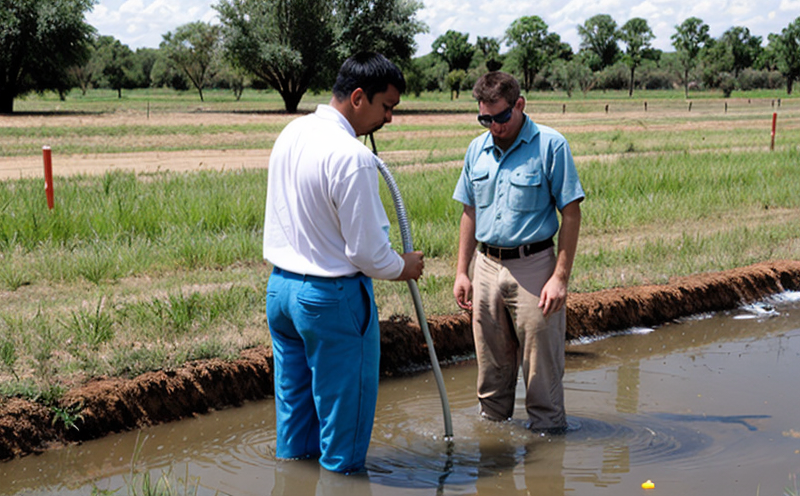APHA 5310B Total Organic Carbon TOC Test in Groundwater
The APHA 5310B method is widely recognized for its precision and reliability in determining the total organic carbon (TOC) content of aqueous samples, including groundwater. This test plays a crucial role in environmental monitoring and water quality assessment by quantifying the amount of carbon present as organic compounds. The significance of this method extends to various sectors such as municipal water treatment, industrial wastewater discharge, and agricultural runoff management.
The TOC measurement is vital for ensuring compliance with regulatory standards set forth by organizations like the Environmental Protection Agency (EPA) in the United States. Regulatory limits on TOC can vary depending on the intended use of the water source. For instance, drinking water supplies must meet stringent criteria to ensure public health safety.
Groundwater is particularly susceptible to contamination from various organic compounds originating from agricultural practices, industrial activities, and urban runoff. Monitoring TOC levels in groundwater provides critical insights into potential pollution sources and helps in implementing targeted mitigation strategies. This method not only aids in regulatory compliance but also supports sustainable water resource management by identifying early signs of contamination.
The APHA 5310B procedure involves the combustion of organic compounds at high temperatures, converting them into carbon dioxide (CO2). The resulting CO2 is then measured using an infrared gas analyzer. This method provides a direct measure of TOC by eliminating other inorganic forms of carbon such as carbonate and bicarbonate ions.
The process begins with proper sample collection and preservation to ensure accurate results. Samples should be collected from representative locations within the groundwater aquifer, taking care to avoid contamination during handling. After collection, samples are transported under refrigerated conditions to prevent microbial activity that could alter TOC concentrations.
Instrumentation used in this method includes a combustion analyzer capable of precise CO2 detection and an infrared gas detector for quantification. The accuracy of these instruments is paramount, requiring regular calibration against certified reference standards.
The following table highlights the key steps involved in the APHA 5310B TOC testing process:
| Step | Description |
|---|---|
| Sample Collection and Preservation | Ensure proper collection from representative locations, refrigerate samples to prevent microbial activity. |
| Preparation for Combustion Analysis | Precisely weigh or volume the sample as required by the method. |
| Combustion and CO2 Generation | Heat the sample in a combustion chamber, converting all organic compounds to CO2. |
| Infrared Detection of CO2 | Measure the concentration of CO2 using an infrared gas detector. |
| Data Interpretation and Reporting | Analyze data to determine TOC levels, ensuring compliance with relevant standards. |
The precision and accuracy of the APHA 5310B method make it an indispensable tool for environmental professionals. By leveraging this method, stakeholders can effectively manage water quality, protect public health, and ensure compliance with stringent regulatory requirements.
Understanding the real-world implications of TOC testing in groundwater is essential for effective management strategies. For example, high TOC levels may indicate contamination from agricultural fertilizers or industrial pollutants. Prompt identification allows for swift corrective actions to prevent broader ecological impacts.
Industry Applications
The APHA 5310B method finds extensive application across various industries, including municipal water treatment facilities, agricultural operations, and industrial manufacturing processes. Below is a table summarizing the key applications:
| Industry | Description of Application |
|---|---|
| Municipal Water Treatment | Detecting organic contaminants in drinking water supplies to ensure compliance with EPA standards. |
| Agricultural Operations | Monitoring runoff from farmlands to prevent contamination of groundwater and surface waters. |
| Industrial Manufacturing | Assessing wastewater discharge levels to meet regulatory requirements for environmental protection. |
| Pharmaceutical Manufacturing | Ensuring product purity by monitoring organic contaminants in production processes. |
| Energy Sector (Oil and Gas) | Identifying and quantifying organic compounds in produced water to manage disposal practices. |
| Chemical Manufacturing | Maintaining product quality and environmental standards by monitoring organic content in manufacturing processes. |
| Retail and Food Services | Monitoring the purity of water used in food processing to ensure hygiene standards are met. |
The versatility of the APHA 5310B method across diverse industries underscores its importance in environmental monitoring. By providing accurate TOC levels, this method supports informed decision-making processes that enhance water quality and protect public health.
Customer Impact and Satisfaction
The implementation of the APHA 5310B TOC testing method has significantly impacted various customer segments. Municipal water treatment facilities have benefited from enhanced monitoring capabilities, leading to more effective pollution control strategies and improved public health outcomes.
- Agricultural stakeholders: Have seen a reduction in the risk of groundwater contamination, fostering sustainable farming practices.
- Industrial clients: Can ensure compliance with stringent discharge limits, thereby mitigating potential fines and reputational damage.
- R&D engineers: Gain valuable insights into product purity and process efficiency, driving innovation and quality improvements.
The method's reliability has not only improved environmental stewardship but also enhanced customer satisfaction through consistent and accurate results. Stakeholders report greater confidence in their ability to manage water resources sustainably, contributing to a healthier ecosystem.
International Acceptance and Recognition
The APHA 5310B method is internationally recognized for its precision and reliability. Below are the key standards that recognize this testing protocol:
- ISO 9001:2015 – Quality management systems, requirements.
- ASTM D4840-13 – Standard test method for organic carbon in water by combustion.
- EN ISO/IEC 17025:2017 – General requirements for the competence of testing and calibration laboratories.
- IEC 62453 – Environmental management systems, requirements with guidance for use.
The widespread acceptance of this method is a testament to its robustness and consistency across various regulatory frameworks. Laboratories adhering to these standards ensure that their TOC testing results are credible and acceptable globally.





